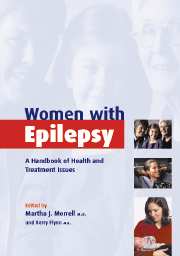Book contents
- Frontmatter
- Contents
- List of contributors
- Part I The woman with epilepsy
- Part II Epilepsy diagnosis and treatment
- Part III Hormones and the brain
- Part IV Health challenges for women with epilepsy
- Part V Family planning, pregnancy, and parenting
- Part VI Living well with epilepsy
- 23 The impact of epilepsy on relationships
- 24 Parenting the daughter with epilepsy
- 25 Safety issues for women with epilepsy
- 26 Legal issues facing women with epilepsy
- 27 Work issues and epilepsy
- Appendix: The Epilepsy Foundation's Campaign for Women's Health: bringing help and hope to women with epilepsy
- Index
- References
25 - Safety issues for women with epilepsy
from Part VI - Living well with epilepsy
Published online by Cambridge University Press: 02 November 2009
- Frontmatter
- Contents
- List of contributors
- Part I The woman with epilepsy
- Part II Epilepsy diagnosis and treatment
- Part III Hormones and the brain
- Part IV Health challenges for women with epilepsy
- Part V Family planning, pregnancy, and parenting
- Part VI Living well with epilepsy
- 23 The impact of epilepsy on relationships
- 24 Parenting the daughter with epilepsy
- 25 Safety issues for women with epilepsy
- 26 Legal issues facing women with epilepsy
- 27 Work issues and epilepsy
- Appendix: The Epilepsy Foundation's Campaign for Women's Health: bringing help and hope to women with epilepsy
- Index
- References
Summary
Health-care providers caring for people with epilepsy generally have the same goals. Those goals are to stop seizures, avoid treatment-related side effects, and ensure a good quality of life. Ideally, no one's life would be significantly changed because of epilepsy. People with epilepsy are usually counseled to take advantage of usual life experiences. On the other hand, some precautions may be necessary, depending on the type of seizures and seizure frequency.
In this chapter, Patricia Dean discusses reasonable safety measures for people with epilepsy to consider. Pat is an Epilepsy Nurse Specialist. Her professional life has focused on the care of people with epilepsy and she is currently at the University of Miami. Pat is also on the Board of Directors of the National Epilepsy Foundation and is President of her local Epilepsy Foundation affiliate, Epilepsy Foundation of South Florida. She provides a reasonable and complete discussion of the risks related to seizures and offers suggestions to ensure seizure safety while leading a full and active life.
MJMA number of published medical studies have examined whether people with epilepsy are at risk for injuries as a result of seizures. Although some studies conclude that there is no higher risk of injury for people with epilepsy than for the general population, other studies suggest that people with seizures are at greater risk (Hauser et al., 1984).
Keywords
- Type
- Chapter
- Information
- Women with EpilepsyA Handbook of Health and Treatment Issues, pp. 263 - 268Publisher: Cambridge University PressPrint publication year: 2003
References
- 1
- Cited by

